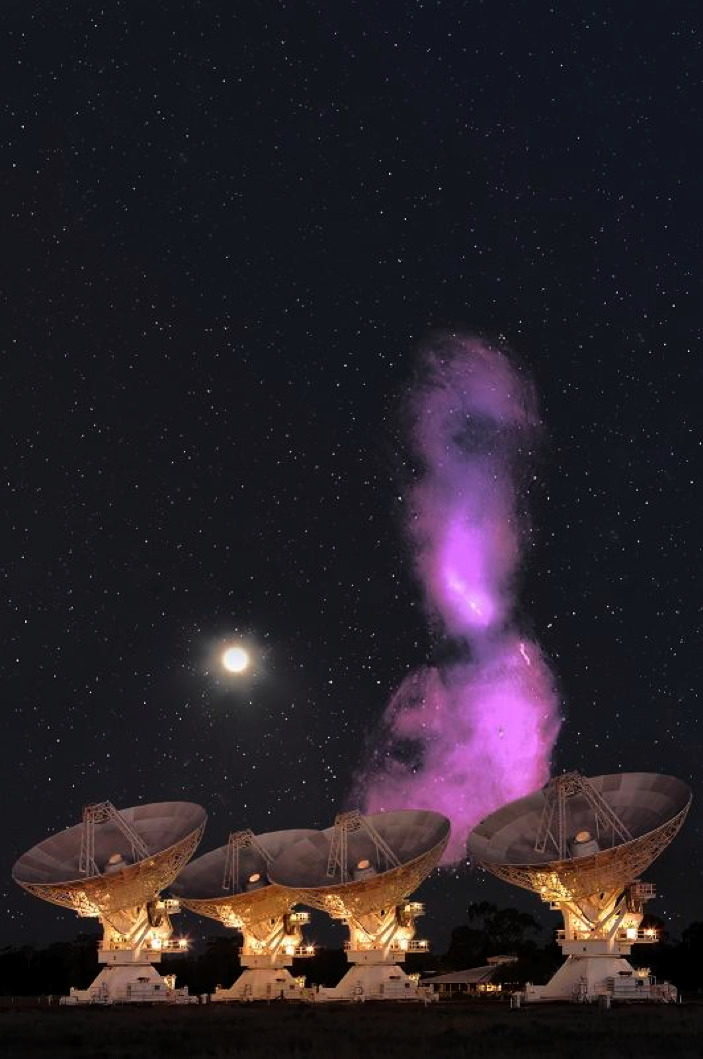
Do you enjoy using your tablet or laptop computer? Many folks nowadays are taking the Internet with them wherever they go, but did you know that you can contribute to citizen science at the same time? Let's try a hunt for black holes while you're carpooling, riding the bus or taking the train to work!
The first Zooniverse project, Galaxy Zoo, was started by astronomers Chris Lintott and Kevin Schawinski in 2006 when they were both at Oxford University. Now there is "Radio Galaxy Zoo" - a brand-new project which just launched and allows anyone with computing power and an Internet connection to become a cosmic explorer.
Just what is Radio Galaxy Zoo? It's a project to help astronomers discover supermassive black holes observed by the KG Jansky Very Large Array (NRAO) and the Australia Telescope Compact Array (CSIRO). It works by matching galaxy images with radio images taken by CSIRO, to work out if a galaxy has a supermassive black hole at its center or not.
"It takes about a minute to learn what to do," said CSIRO's Dr. Julie Banfield, an Australian coordinator of the international project.

Centaurus A (purple): A giant galaxy with a supermassive black hole, typical of the galaxies in Radio Galaxy Zoo, super-imposed with CSIRO Image (radio) I Feain et al. (photo) S. Amy.
We know that almost all - if not all - galaxies have a black hole at their hearts. We also know that the larger the host galaxy is, the larger the black hole should be. These huge black holes have wide ranging effects on the galaxy in which they are contained. The supermassive variety can swallow up nearby materials and grow to billions of times the mass of the Sun! These monsters are known to produce incredible jets of material, which spew out at the speed of light. There are circumstances where these jets can't be observed in visible light, but can be detected in the radio end of the electromagnetic spectrum. Astronomers can use your help locating these jets and associating them to their host galaxies.
"To actually work with the images takes only a few seconds each - perhaps a couple of minutes for the really tough ones," says Dr. Banfield. "You just need match up a couple of pictures and look for what you think is the galaxy at their center."
Why do astronomers need your help in sifting through all this radio data? Imagine the hundreds of thousands of galaxies out there just waiting to reveal their secrets. Because not even light can escape a black hole, they cannot be directly observed, yet they have a huge impact on their immediate surroundings. There are many methods for detecting black holes in their neighborhoods, but the supermassive types are fairly easy. While optical and infrared light is usually blocked by copious amounts of dust and gas, the target of the project - those tell-tale jets - are readily apparent at radio wavelengths.
"There is a great deal of valuable information that can be obtained from the radio images of these jets, but we need to understand the host galaxy too," says the Radio Galaxy Zoo team. "For instance, observing the host galaxy allows us to determine its distance, which is critical to understanding how big and how luminous the black hole actually is."
Join up at Radio Galaxy Zoo and you'll be part of a community of almost a million people who work in the 'Zooniverse' - a set of citizen-science projects covering everything from galaxy shapes to cancer data and whale songs.
"Galaxy Zoo and the other projects have been producing real science, science that gets published," said CSIRO's Dr. Ivy Wong, who has also been working to set up Radio Galaxy Zoo. "Everyone, literally everyone, can now help to make discoveries."
Go ahead, team up! Instead of just aimlessly wandering around the Internet while waiting on an appointment, commuting, or site surfing for the fun of it, you could be contributing to a real science project and assisting astronomers in locating black holes!
About Tammy Plotner - Tammy is a professional astronomy author, President Emeritus of Warren Rupp Observatory and retired Astronomical League Executive Secretary. She's received a vast number of astronomy achievement and observing awards, including the Great Lakes Astronomy Achievement Award, RG Wright Service Award and the first woman astronomer to achieve Comet Hunter's Gold Status.















